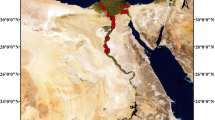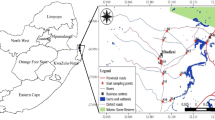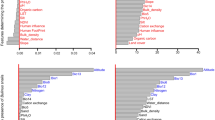Abstract
Schistosomiasis remains a major public health concern affecting approximately 12 million people in the Philippines due to inadequate information about the disease and limited prevention and control efforts. Schistosoma japonicum, one of the causative agents of the disease, requires an amphibious snail Oncomelania hupensis quadrasi (O. h. quadrasi) to complete its life cycle. Using the geographical information system (GIS) and maximum entropy (MaxEnt) algorithm, this study aims to predict the potential high-risk habitats of O. h. quadrasi driven by environmental factors in the Philippines. Based on the bioclimatic determinants, a very high-performance model was generated (AUC = 0.907), with the mean temperature of the driest quarter (25.3%) contributing significantly to the prevalence of O. h. quadrasi. Also, the snail vector has a high focal distribution, preferring areas with a pronounced wet season and high precipitation throughout the year. However, the findings provided evidence for snail adaptation to different environmental conditions. High suitability of snail habitats was found in Quezon, Camarines Norte, Camarines Sur, Albay, Sorsogon, Northern Samar, Eastern Samar, Leyte, Bohol, Surigao del Norte, Surigao del Sur, Agusan del Norte, Davao del Norte, North Cotabato, Lanao del Norte, Misamis Occidental, and Zamboanga del Sur. Furthermore, snail habitat establishment includes natural and man-made waterlogged areas, with the progression of global warming and climate change predicted to be drivers of increasing schistosomiasis transmission zones in the country.









Similar content being viewed by others
Data availability
The data used in this research are available by the corresponding author upon reasonable request.
References
Abao-Paylangco RA, Balamad MKM, Paylangco JC, Japitana RA, Jumawan JC (2019) Schistosoma japonicum in selected rice fields surrounding Lake Mainit Philippines. J Eco Sci Eco-Gov 1(1):15–24
Adekiya TA, Aruleba RT, Oyinloye BE, Okosun KO, Kappo AP (2020) The effect of climate change and the snail-schistosome cycle in transmission and bio-control of schistosomiasis in Sub-Saharan Africa. Int J Environ Res Public Health 17(1):181. https://doi.org/10.3390/ijerph17010181
Almadrones-Reyes KJ, Dagamac NHA (2018) Predicting local habitat suitability in changing climate scenarios: applying species distribution modeling for Diderma hemisphaericum. Curr Res Environ App Mycol 8(5):492–500. https://doi.org/10.5943/cream/8/5/2
Anderson RP, Lew D, Peterson AT (2003) Evaluating predictive models of species’ distributions: criteria for selecting optimal models. Ecol Model 162(3):211–232. https://doi.org/10.1016/S0304-3800(02)00349-6
Araújo MB, Peterson AT (2012) Uses and misuses of bioclimatic envelope modeling. Ecology 93(7):1527–1539. https://doi.org/10.1890/11-1930.1
Braun L, Grimes JET, Templeton MR (2018) The effectiveness of water treatment processes against schistosome cercariae: A systematic review. PloS Negl Trop Dis 12(4):e0006364. https://doi.org/10.1371/journal.pntd.0006364
Buebos-Esteve DE, Mamasig GDNS, Ringor AMD, Layog HNB, Murillo LCS, Dagamac NHA (2023) Modeling the potential distribution of two immortality flora in the Philippines: applying MaxEnt and GARP algorithms under different climate change scenarios. Model Earth Syst Environ 9(2):2857–2876. https://doi.org/10.1007/s40808-022-01661-7
Carabin H, Mcgarvey ST, Sahlu I et al (2015) Schistosoma japonicum in Samar, the Philippines: infection in dogs and rats as a possible risk factor for human infection. Epidem Infect 143(8):1767–1776
Çoban HO, Örücü ÖK, Arslan ES (2020) MaxEnt modeling for predicting the current and future potential geographical distribution of Quercus libani Olivier. Sustainability 12(7):2671. https://doi.org/10.3390/su12072671
Dagamac NHA, Bauer B, Woyzichovski J, Shchepin ON, Novozhilov YK, Maxen SM (2021) Where do nivicolous myxomycetes occur?–modeling the potential worldwide distribution of Physarum albescens. Fungal Ecol 53:101079. https://doi.org/10.1016/j.funeco.2021.101079
Department of Health (2018) Schistosomiasis control program. Retrieved from https://doh.gov.ph/schistosomiasis-control-program. Accessed 12 May 2021
Elith J, Franklin J (2013) Species Distribution Modeling. Encycl Biodiv 6:692–705
Elith J, Kearney M, Phillips S (2010) The art of modeling range-shifting species. Meth Ecol Evol 1(4):330–342. https://doi.org/10.1111/j.2041-210X.2010.00036.x
Fornillos RJ, Sato MO, Tabios IK et al (2019) Detection of Schistosoma japonicum and Oncomelania hupensis quadrasi environmental DNA and its potential utility to schistosomiasis japonica surveillance in the Philippines. PLoS One 14(11). https://doi.org/10.1371/journal.pone.0224617
Fornillos RJC, Fontanilla IKC, Chigusa Y et al (2019b) Infection rate of Schistosoma japonicum in the snail Oncomelania hupensis quadrasi in endemic villages in the Philippines: need for snail surveillance technique. Trop Biomed 36(2):402–411
Head JR, Chang H, Li Q, Hoover CM, Wilke T, Clewing C, Carlton EJ, Liang S, Lu D, Zhong D, Remais JV (2016) Genetic evidence of contemporary dispersal of the intermediate snail host of Schistosoma japonicum: movement of an NTD host is facilitated by land use and landscape connectivity. PLoS Negl Trop Dis 10(12):e0005151. https://doi.org/10.1371/journal.pntd.0005151
Kigen C, Okoth P, Konje M et al (2013) Modeling the Spatial Impact of Climate Change on Grevy’s Zebra (Equus grevyi) niche in Kenya. Elixir Remote Sens 62:17608–17611
King CH (2008) Where Snails No Longer Fear to Tread. Am J Trop Med Hyg 78(2):185
Kumar S, Neven LG, Yee WL (2014) Evaluating correlative and mechanistic niche models for assessing the risk of pest establishment. Ecosphere 5(7):86. https://doi.org/10.1890/ES14-00050.1
Legaspino RT, Metillo EB, Claveria FG (2014) Distribution of Oncomelania quadrasi (Mollendorf 1895) and prevalence of infected snails in schistosomiasis endemic villages of Kapatagan and Lala, Lanao del Norte. Philippines IAMURE Int J Ecol Conserv 11:87
Leonardo L, Varona G, Fornillos RJ, Manalo D, Tabios IK, Moendeg K, ... and Fontanilla IK (2020) Oncomelania hupensis quadrasi: snail intermediate host of Schistosoma japonicum in the Philippines. Acta Trop 210: 105547. https://doi.org/10.1016/j.actatropica.2020.105547
Leonardo L, Hernandez L, Magturo TC, Palasi W, Rubite JM, de Cadiz A, Moendeg K, Fornillos RJ, Tabios IK, Mistica M, Fontanilla IK (2019) Current status of neglected tropical diseases (NTDs) in the Philippines. Acta Trop 105284. https://doi.org/10.1016/j.actatropica.2019.105284
Leonardo L, Rivera P, Saniel O, Villacorte E, Lebanan MA, Crisostomo B, Hernandez L, Baquilod M, Erce E, Martinez R (2012) Velayudhan R (2012) A national baseline prevalence survey of schistosomiasis in the Philippines using stratified two-step systematic cluster sampling design. J Trop Med 2012:936128. https://doi.org/10.1155/2012/936128
Leonardo L, Rivera P, Saniel O, Solon JA, Chigusa Y, Villacorte E, Chua JC, Moendeg K, Manalo D, Crisostomo B, Sunico L, Boldero N, Payne L, Hernandez L, Veladyuhan R (2015) New endemic foci of schistosomiasis infections in the Philippines. Acta Trop 141:354–360. https://doi.org/10.1016/j.actatropica.2013.03.015
Leonardo LR, Varona G, Fornillos RJ, Manlo D, Tabios IK, Moendeg K, de Cadiz A, Kikuchi M, Chigusa Y, Mistica M, Hernandez L, Palasi W, Fontanilla IK (2020) Oncomelania hupensis quadrasi: Snail intermediate host of Schistosoma japonicum in the Philippines. Acta Trop 105547. https://doi.org/10.1016/j.actatropica.2020.105547
Limbo-Dizon JE, Almadrones-Reyes KJ, Macabago SAB, Dagamac NHA (2022) Bioclimatic modeling for the prediction of the suitable regional geographical distribution of selected bright-spored myxomycetes in the Philippine archipelago. Biodiversitas 23(5): https://doi.org/10.13057/biodiv/d230506
Madsen H, Carabin H, Balolong D, Tallo VL, Olveda R, Yuan M, McGarvey ST (2008) Prevalence of Schistosoma japonicum infection of Oncomelania quadrasi snail colonies in 50 irrigated and rain-fed villages of Samar Province, the Philippines. Acta Trop 105(3):235–241. https://doi.org/10.1016/j.actatropica.2007.12.002
Manyangadze T, Chimbari MJ, Gebreslasie M et al (2016) Modelling the spatial and seasonal distribution of suitable habitats of schistosomiasis intermediate host snails using Maxent in Ndumo area, KwaZulu-Natal Province. S Afr Parasit Vectors 9:572. https://doi.org/10.1186/s13071-016-1834-5
Mas-Coma S, Valero MA, Bargues MD (2009) Climate change effects on trematodiases, with emphasis on zoonotic fascioliasis and schistosomiasis. Vet Parasitol 163(4):264–280. https://doi.org/10.1016/j.vetpar.2009.03.024
Mutuku MW, Dweni CK, Mwangi M et al (2014) Field-derived Schistosoma mansoni and Biomphalaria pfeifferi in Kenya: a compatible association characterized by lack of strong local adaptation, and presence of some snails able to persistently produce cercariae for over a year. Parasit Vectors 7(1):1–13. https://doi.org/10.1186/s13071-014-0533-3
Olveda DU, Li Y, Olveda RM et al (2014) Bilharzia in the Philippines: past, present, and future. Int J Infect Dis 18:52–56. https://doi.org/10.1016/j.ijid.2013.09.011
Phillips SJ, Anderson RP, Schapire RE (2006) Maximum entropy modeling of species geographic distributions. Ecol Model 190:231–259. https://doi.org/10.1016/j.ecolmodel.2005.03.026
Phillips SJ, Dudik M, Schapire RE (2021) Maxent software for modeling species niches and distributions (Version 3.4.4). Retrieved from https://biodiversityinformatics.amnh.org/open_source/maxent/. Accessed 14 Feb 2021
Pocheville A (2015) The ecological niche: history and recent controversies. In Handbook of Evolutionary Thinking in the sciences pp 547–586
Ponpetch K, Erko B, Bekana T, Kebede T, Tian D, Yang Y, Liang S (2021) Environmental drivers and potential distribution of Schistosoma mansoni endemic areas in Ethiopia. Microorganisms 9:2144. https://doi.org/10.3390/microorganisms910214
Rekha Sarma R, Munsi M, Neelavara Ananthram A (2015) Effect of climate change on invasion risk of giant African snail (Achatina fulica Férussac, 1821: Achatinidae) in India. PLoS ONE 10(11):e0143724
RStudio Team (2020) RStudio: Integrated Development for R. RStudio, PBC, Boston, MA. Retrieved from http://www.rstudio.com/. Accessed 15 Feb 2021
Sousa VD, Driessnack M, Mendes IAC (2007) An overview of research designs relevant to nursing: Part 1: quantitative research designs. Revistalatino-Am De Enfermagem 15(3):502–507
Steinmann P, Keiser J, Bos R, Utzinger TM, J (2006) Schistosomiasis and water resources development: systematic review, meta-analysis, and estimates of people at risk. Lancet Infect Dis 6:411–425. https://doi.org/10.1016/S1473-3099(06)70521-7
Utzinger J, Raso G, Brooker S, De Savigny D, Tanner M, Ornbjerg N, Singer BH, N’goran EK (2009) Schistosomiasis and neglected tropical diseases: Towards integrated and sustainable control and a word of caution. Parasitology 136(13):1859–1874. https://doi.org/10.1017/S0031182009991600
Warren DL, Seifert SN (2011) Ecological niche modeling in Maxent: the importance of model complexity and the performance of model selection criteria. Ecol App 21(2):335–342. https://doi.org/10.1890/10-1171.1
World Health Organization (2010) Working to overcome the global impact of neglected tropical diseases: first WHO report on neglected tropical diseases (No. WHO/HTM/NTD/2010.1). World Health Organization. Retrieved https://www.who.int/publications/i/item/9789241564090. Accessed 14 May 2021
Yaro CA, Kogi E, Luka SA (2018) Spatial Distribution and Modeling of Soil Transmitted Helminthes Infection in Nigeria. Adv Infect Dis 8:82–107. https://doi.org/10.4236/aid.2018.82010
Yuan HS, Wei YL, Wang XG (2015) Maxent modeling for predicting the potential distribution of Sanghuang, an important group of medicinal fungi in China. Fungal Ecol 17:140–145. https://doi.org/10.1016/j.funeco.2015.06.001
Zheng JX, Xia S, Lv S, Zhang Y, Bergquist R, Zhou X (2021) Infestation risk of the intermediate snail host of Schistosoma japonicum in the Yangtze River Basin: Improved results by spatial reassessment and a random forest approach. Infect Dis Poverty 10(1):74. https://doi.org/10.1186/s40249-021-00852-1
Acknowledgements
NHAD acknowledges the support of DOST-PCAARRD as a Balik Scientist Grantee and to the UST-RCNAS for the small financial support in conducting this collaborative research study. All authors are indebted to the two anonymous reviewers who helped improve the quality of this study.
Author information
Authors and Affiliations
Contributions
Conceptualization: LMR-M and NHAD.
Data collection, curation, processing, and analysis: ABMA, BMMB, RNBB, SMLD, JMRM.
Methodology: ABMA, BMMB, RNBB, SMLD, JMRM, NHAD.
Supervision: LMR-M.
Writing of initial draft: ABMA, NHAD.
Reviewing: LMR-M, NHAD.
Editing: LMR-M.
All authors reviewed the final version and agreed to its current presentation.
Corresponding author
Ethics declarations
Ethics approval
Not applicable.
Consent to participate
Not applicable.
Consent for publication
All of the authors consented to publish this manuscript.
Competing interests
The authors declare no competing interests.
Additional information
Section Editor: Pengfei Cai
Publisher's Note
Springer Nature remains neutral with regard to jurisdictional claims in published maps and institutional affiliations.
Rights and permissions
Springer Nature or its licensor (e.g. a society or other partner) holds exclusive rights to this article under a publishing agreement with the author(s) or other rightsholder(s); author self-archiving of the accepted manuscript version of this article is solely governed by the terms of such publishing agreement and applicable law.
About this article
Cite this article
Recopuerto-Medina, L.M., Aguado, A.B.M., Baldonado, B.M.M. et al. Predicting the potential nationwide distribution of the snail vector, Oncomelania hupensis quadrasi, in the Philippines using the MaxEnt algorithm. Parasitol Res 123, 41 (2024). https://doi.org/10.1007/s00436-023-08032-w
Received:
Accepted:
Published:
DOI: https://doi.org/10.1007/s00436-023-08032-w




